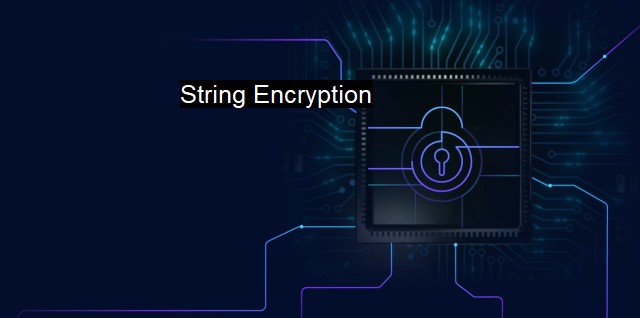What is String Encryption?
Exploring the Importance and Limitations of String Encryption: A Comprehensive Study of Its Algorithms, Significance in Antivirus Programs, and Process of Protection of Confidential Data.
String encryption is a critical subset of cybersecurity strategies that works to protect sensitive data from unauthorized individuals and systems and even malicious attacks that may compromise the security or privacy of the information. In simple terms, string encryption, sometimes termed text encryption, is a technique used to scramble the contents of a message, such that only the parties having the appropriate encryption and decryption keys can decipher the message. By introducing system complexity and creating a massive deterrent to potential hackers, string encryption is elemental in reinforcing overall system and information safety.Understanding string encryption involves looking at the two broad types: symmetric key algorithm and public-key encryption. Symmetric key algorithm signifies where the encryption and decryption keys are similar. Both the sender and the receiver should have access to these keys. The most common symmetric encryption is the Advanced Encryption Standard (AES), where data is divided into blocks and encrypted. Conversely, with public-key encryption, different keys are used for encoding and decoding. RSA (Rivest-Shamir-Adleman) is a familiar public-key encryption where the public key encrypts and a private key decrypts.
This dichotomy is crucially important because it underscores the usability and, correspondingly, the vulnerability of certain encryption types. Symmetric encryption is more suitable for big data, given its quicker encoding speed. the requirement for a secret shared key heightens its vulnerability. In contrast, public-key is safer because even if the public key is hacked, without the private key, the data is negligibly valuable.
String encryption finds relevance in various forms within the cybersecurity domain. Potentially, the most primary application is protecting sensitive data, be it business data or personal. Whether it's customer information, financial transactions, business emails, or user names and passwords used for login credentials, encrypting these data strings can prevent cowled violation, malpractice, and cybercriminal infiltration.
Another relevant area is on the internet, primarily where websites need to protect data transmitted between a client's web browser and their servers. The HTTPS (Hypertext Transfer Protocol Secure) uses the Secure Socket Layer/Transport Layer Security encryption techniques to safeguard this communication data. Whenever confidential data, such as credit card numbers, are transmitted, encryption becomes essential.
Encryption activates a vital role in antivirus strategies. Traditional antiviruses can detect malicious software (malware) by scanning files and examining suspicious behaviour patterns. But today, cyber-attacks have evolved to be more sophisticated, many using cryptographic codes that cloak their identity circuitously. This is where strong string encryption can step in. By encrypting an organization's data strings, they make it exponentially harder for malware or hacker-initiated programs to decipher or misuse the data, thus providing an expansive shield against intrusive entities.
String encryption and its utility are not devoid of challenges. Computing power and time resources required for encryption, especially now with the explosion of cloud data and big data, can be extensive. Another concern is effective key management. Loss or unauthorized access to encryption keys may lead to irremediable data loss or security breaches.
Conclusion being, string encryption is indeed paramount in our current digitized reality. Alongside other cybersecurity strategies, it facilitates the safeguarding of sensitive information, affirms systems integrity, and diminishes the growing vulnerabilities that arise from open networks. encryption is now integrating with artificial intelligence to foster next-generation password protection, network security, and threat detection. String encryption hence remains a motile space that will continue to evolve with the ever-expanding cybersecurity landscape.

String Encryption FAQs
What is string encryption?
String encryption is a technique used to transform plain text or strings of characters into encoded or encrypted text that is not readable by unauthorized parties. It is a critical cybersecurity measure used in antivirus programs and other security solutions to secure sensitive data against cyber attacks.What is the purpose of string encryption in cybersecurity and antivirus?
The primary purpose of string encryption in cybersecurity and antivirus is to protect sensitive information by making it difficult for hackers and cybercriminals to read, steal or tamper with data. The encrypted data is only accessible by authorized people or devices, and this makes it a vital tool for enhancing data protection and privacy.What are the common string encryption algorithms used in cybersecurity and antivirus solutions?
Some common string encryption algorithms used in cybersecurity and antivirus solutions include Advanced Encryption Standard (AES), RSA, Blowfish, and Triple Data Encryption Standard (3DES). These algorithms are widely used because they provide strong encryption capabilities that make it difficult for hackers and cybercriminals to break through the security barriers.What are the benefits of string encryption in antivirus software?
String encryption provides numerous benefits to antivirus software. It enables the antivirus program to encrypt sensitive data, such as passwords, credit card numbers, personal identification information, and other confidential data. This helps to prevent identity theft, data breaches, and cyber attacks. Additionally, string encryption can help to detect and block malware that may try to steal or access encrypted data. Overall, string encryption is a vital cybersecurity tool that helps to enhance data privacy, integrity, and security.| | A | | | B | | | C | | | D | | | E | | | F | | | G | | | H | | | I | | | J | | | K | | | L | | | M | |
| | N | | | O | | | P | | | Q | | | R | | | S | | | T | | | U | | | V | | | W | | | X | | | Y | | | Z | |
| | 1 | | | 2 | | | 3 | | | 4 | | | 7 | | | 8 | | |||||||